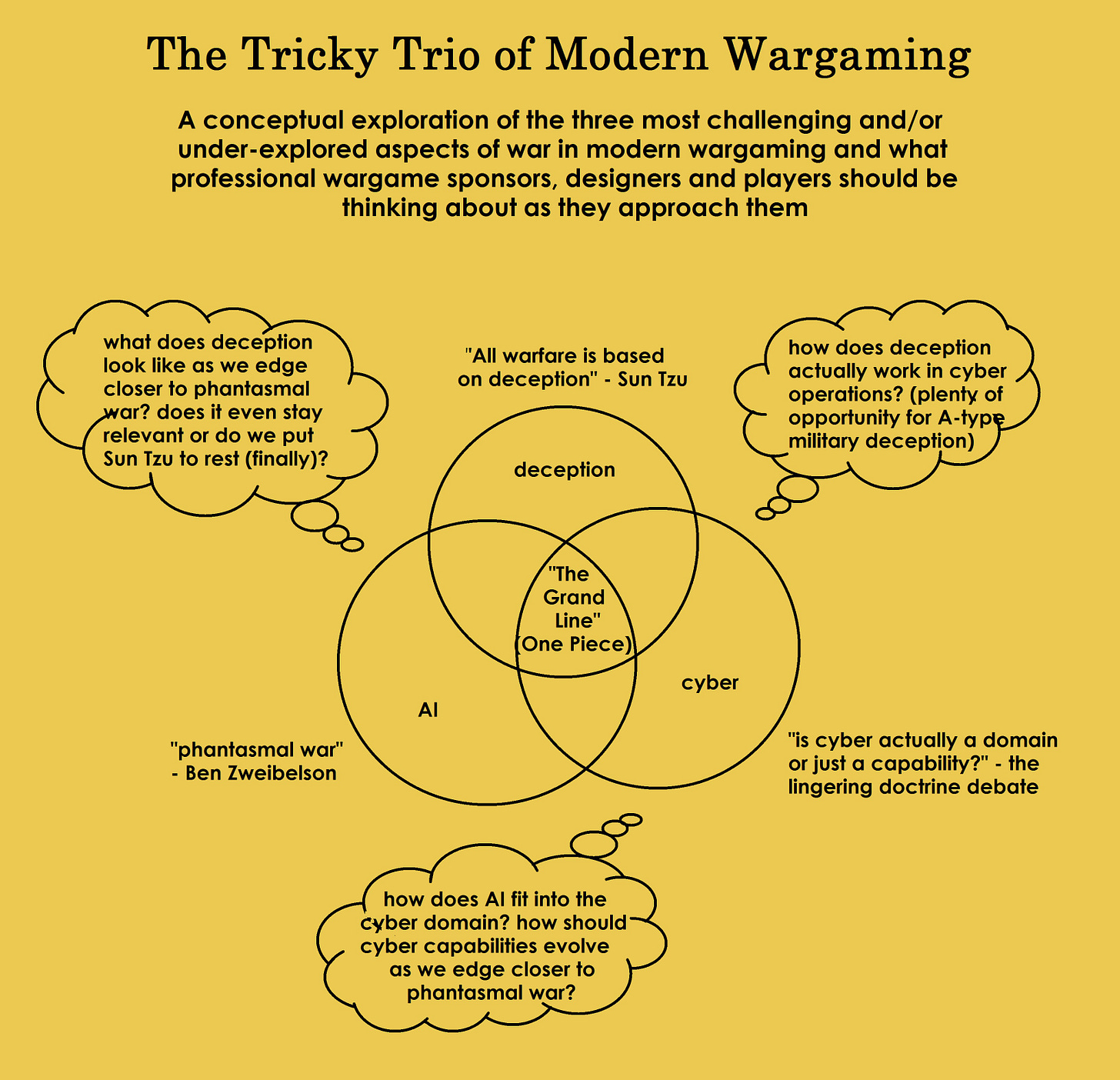Wargaming Weekly #023: Will this micro-wargame turn you into a super hacker?
Not really! Here’s what I have learned about cyber warfare from playing Cyber Strike by Clint Warren-Davey
A few weeks ago, as I dipped my toes deeper into the waters of micro-wargaming with Curtis Miller’s Ambush from the Depths, renowned Australian wargame designer and educator Clint Warren-Davey recommended that I try out his game Cyber Strike next.
And I promised that I would so despite getting distracted this past couple of weeks, when my micro-wargame obsession kicked back in this week, I knew exactly which gem from Sebastian Bae’s Indo-Pacific Micro Games series would scratch the itch.
This is now the 4th wargame I have played so far!
Why was I eager to play Cyber Strike?
First of all, Clint has the highest insights per capita in the wargame design community on X. week in, week out, he shares great tips and deep-dives on game mechanics on his account… and great jokes too!
Secondly, having just written about how wargaming has overlooked economic warfare, I was intrigued by the game’s economic angle with Industry cards that generate revenue every turn.
Lastly, cyber is one third of what I consider “The Tricky Trio of Modern Wargaming” that I have previously written about here so I was keen to finally try a cyber warfare game.
Why did I struggle with Cyber Strike at first?
For starters, during Set Up, I wasn’t sure what to do with the counters not bought by the Blue player from the 12 they pick from the Start pile (as well what to do with Red’s “left-overs” too after they pick from their 12 too). I realized I was unnecessarily overthinking this and resolved to just tuck them to the bottom of the pile.
Secondly, I was a bit confused about when exactly to add counters to the Market from the Start pile: I decided to go with right before the next player’s turn, not right after the current player has purchased counters from the Market. I didn’t want a scenario where a player doesn’t get to deploy what they just bought because the End Game counter has been drawn during replenishment right after their purchase.
However, the real confusion lay with the rules around placement of Defences i.e. the difference between Initial Defences (the ones purchased during Set Up) and regular Defences (the ones purchased after Set Up). My interpretation is that the Initial Defences should be tucked under the respective Industry cards (in order for the other player to not see where they are placed) i.e. the opponent doesn’t even know they’re there in the first place let alone how strong they are while regular Defences are placed on top of Industry card albeit face-down i.e. the opponent knows they’re there but not exactly how strong they are.
Fortunately, since I was playing both sides, I didn’t need to bother with actually hiding any Defences (played with all of them face-up on the Industry cards) but I think it might be worth clarifying this for a real two-player scenario.
What do I like about Cyber Strike?
Unlike all the previous wargames I’ve played… no dice! Not that I have anything against dice per se but it was interesting to finally experience a wargame without them.
I found that this meant that the only time my attacks failed was when I launched them without sufficient information about the opponent’s Defences. Otherwise, even the weakest attack is more or less a sure deal when you know (from a Probe action or a previous successful attack) how fortified (or not) a specific Industry is.
I also noticed that once you’re done playing for the educational value and you just want to win, this game has serious potential for “card counting”. I think with a little effort, you can keep track of the counters going in and out of the Market, which ones have been deployed as Defences, and which ones are already in the Used pile, in order to deduce what your opponent is holding secretly in hand as Exploits (without having to spend a Probe action to find out). This intrigues the blackjack lover in me!
The only thing I don’t like is how cumbersome it is to manage the Start pile. Due to the size and thinness of the counters, it can be a bit frustrating to peel them off the pile with your thumb and index or middle finger during Set Up or Market replenishment.
The game could definitely use slightly larger counters that are easier to pick up but this is understandable given its print ‘n’ play nature. The other micro-wargames I have previously played have counters of a similar size but I didn’t need to pick them up off each other as often as these ones, instead mostly needing to just slide them across the game board.
What are my top 10 player tips for Cyber Strike?
SPOILER ALERT! Skip this part if you want to explore the game for yourself from first principles!
1. Place your industries in two rows. Even though Clint recommends putting them all in one row in the rules, I have found that placing them in two: one for the 2 VP cards and one for the 1 VP cards makes everything easier for me to track both visually and cognitively. Also, Clint recommends turning the cards sideways when they are Disabled (from upright when they are Active) but I found that despite being a bit more cumbersome, turning them completely upside down is actually more satisfying, haha!
2. When playing as China, use the little you get ($8) for Initial Defences to fortify your Military (since you can’t do Cyber Attack actions if that Industry card is inactive, and you can’t win as China if you’re not aggressive enough). However, since this is the logical action to take, this means there’s a subtle opportunity for deception so you can also try catching your U.S. opponent off-guard by fortifying your Finance or Heavy Industry instead for revenue resilience.
3. Cyber Attack actions are not available for both players in the first turn. When playing as China, use your first turn to Probe your opponent’s Military, Government and Finance industries. This enables you to know exactly how much you need in Exploits to Disable them (for maximum VPs at the end of the game), since they are the ones most likely to get Initial Defences from the U.S. player during Set Up.
4. When playing as the U.S., it makes sense to use your first turn to Prepare (you can safely assume that the little Initial Defence your Chinese counterpart will go to fortifying their Military). If you combine this Prepare counter well with Research and Attack actions, you can deal a crucial well-timed blow that cripples your Chinese opponent for the rest of the game despite them getting to go first every turn.
5. As soon as you can (second turn onwards), draw first blood! Especially if you’re playing as China, the sooner you can take out 4 of your opponent’s Industries in one fell swoop and reduce their revenue from $8 to $3 using either yellow or blue vulnerability Exploits, the better.
6. If you’re playing as the U.S, counter-attack as soon as possible (even with a low intensity yellow or blue counter), you can’t afford to let China successfully attack you twice in a row with full $8 revenue. Despite the temptation to first focus on repairing all your industries, you should do whatever it takes to get your opponent down to $3 revenue as soon as you can.
7. Attack with overwhelming force when you attack the red vulnerability Industry cards i.e. Military, Government and Finance to maximize VPs. Use a total of 13 Exploit strength to be on the safe side since Military and Government have +2 Intrinsic Defence if you haven’t done a Probe action to find out exactly what Defences are there.
8. Literally take notes of your enemy’s Defences when you do a Probe action (so that you don’t forget what is revealed to you) and also during adjudication of your Cyber Attack actions so that you can use that intelligence to spend less on Exploits in future attacks.
9. When attacking a string of enemy Industries, start with the one(s) you anticipate/know have the least Defence capability so that your attack doesn’t fail and end on first impact, going completely to waste and giving away a free action to your opponent.
10. Early in the game, you can afford to let Government and Technology stay down for a turn or two if they get hit but you should always repair Military quickly (you need to attack and counter-attack as often as possible). Also always repair Finance and Heavy Industry quickly (you need that revenue to stay in the game).
What are my 4 key take-ways from playing Cyber Strike?
1. The key design lesson I have taken away from this is that despite how ubiquitous they are in the world of wargaming, you don’t need dice to design a solid wargame. Reminds me of that song about how you don’t needs dreadlocks to be Rasta!
2. I’m also intrigued by the use of asymmetry in this game, with the U.S. having way more budget than China to spend on Initial Defences during Set Up. I’m keen to see how the game would turn out if we used a $16-to-$8 U.S.-to-China split instead of the $24-to-$8 currently prescribed.
3. Just like Call Sign and Ambush from the Depths, this game is also BEGGING to be digitized (especially the adjudication) and since there are no hexes and no dice, I think its cards and counters can fit comfortably on mobile in landscape orientation.
4. As fully explained in his design notes, the key insights that Clint seeks to share with this game are:
· How deep a successful attack goes. Multiple industries that share a vulnerability can be taken down by one attack and yet fortifying against one vulnerability automatically leaves that industry completely exposed to another (except for those that have only one) or leaves other industries completely undefended.
· A successful attack is also a successful reconnaissance mission. You get to know which Industry cards are “naked” during adjudication and can hence confidently return to attack them again with even lower Exploits, without needing to do a separate Probe action. Even the lowest intensity attack can sweep across multiple industries with the right intelligence.
· Even the strongest Defences can be overcome with a determined, focused attacked. In this game, Defences max out at 10 or 12 (highest individual counter is a 5, only two can be used on an Industry at a time, while Exploits can be bunched up to 13 and more)
· Cyber warfare is a continuous swinging match. When you’re weak, you have to strike first (or else you won’t recover from your opponent’s first strike). When you’re strong, you have to retaliate decisively (or else your strength gets eroded away quickly).
All in all, I left this game with a deeply disturbing feeling that cyber warfare is a lot like this robot arm art piece that goes viral on social media every few months:
Yours in hex,
Rwizi.
…
SUPPORT MY NEWSLETTER!
If you enjoy this newsletter, you can support me in any one of the following three super-specific ways:
1. Leave a comment below! (Punching a good hole in any of the facts or arguments shared above.)
2. Book a wargame play-date with me! (I’m available to play Twilight Struggle via mobile app on Friday or Sunday: please DM me via X or LinkedIn to sync.)
3. Give me a warm intro to your friend at a16z! (Preferably someone who’s on either the a16z speedrun team or the a16z Games team. I’m looking for brutal feedback on a speedrun application my startup made last year: once again, please DM me via X or LinkedIn to sync.)
ABOUT THE AUTHOR:
Wargaming Weekly is curated, written and published by Rwizi Rweizooba Ainomugisha, a freelance writer, game designer and startup entrepreneur. Rwizi currently serves as Co-Founder, Co-CEO and Chief Strategy Officer (CSO) at Lupiiya Books - the social finance app that is gamifying the fundraising process for young African entrepreneurs. Wargaming Weekly is a curiosity chronicle of Rwizi’s exploration of the wargaming world… for the love of games in general, for the desire to contribute to the growth of wargaming in particular as a discipline, and lastly, for the hope of finding cutting-edge game design innovations to bring back with him to the startup world.












